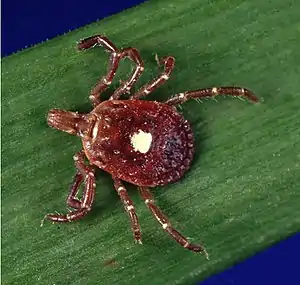Haemaphysalis anomala
Haemaphysalis anomala is a hard-bodied tick of the genus Haemaphysalis. It is found in India, Vietnam and Sri Lanka.[1] It is an obligate ectoparasite of mammals.
| Haemaphysalis anomala | |
|---|---|
| Scientific classification | |
| Kingdom: | |
| Phylum: | |
| Class: | |
| Subclass: | |
| Superorder: | |
| Order: | |
| Family: | |
| Subfamily: | |
| Genus: | |
| Species: | H. anomala |
| Binomial name | |
| Haemaphysalis anomala Warburton, 1913 | |
| Synonyms | |
| |
Parasitism
Adults parasitize various mammals such as Bubalus bubalis[2] and domestic cattle. Larva and nymphs are parasite on birds such as Centropus sinensis and small mammals like Rattus species.[3] It is a potential vector of Kyasanur Forest disease virus.[4]
References
- "Species Details : Haemaphysalis anomala Warburton, 1913". Catalogue of Life. Retrieved 6 February 2017.
- Miranpuri, GS (1988). "Ticks parasitising the Indian buffalo (Bubalus bubalis) and their possible role in disease transmission". Vet. Parasitol. 27 (3–4): 357–62. doi:10.1016/0304-4017(88)90050-7. PMID 3369083.
- Hoogstraal, Harry; Dhanda, Vijai; Bhat, H. R (1972). "Haemaphysalis (Kaiseriana) anomala Warburton (Ixodoidea: Ixodidae) from India: Description of Immature Stages and Biological Observations". The Journal of Parasitology. 58 (3): 605–610. doi:10.2307/3278216. JSTOR 3278216. PMID 5042066.
- Sreenivasan, M. A.; Rajagopalan, P. K. (1981). "Ixodid ticks on cattle and buffaloes in the Kyasanur forest disease area of Karnataka State [1981]". Indian Journal of Medical Research. Retrieved 6 February 2017.
This article is issued from Wikipedia. The text is licensed under Creative Commons - Attribution - Sharealike. Additional terms may apply for the media files.
